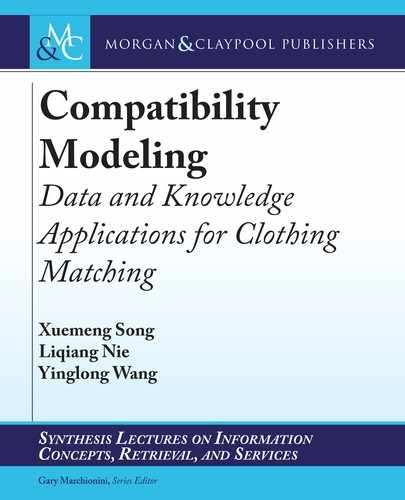
7.3. PCW-DC 85
Algorithm 7.4 Personalized Capsule Wardrobe Creation Algorithm.
Input: User original wardrobe I
u
D fi
u
ck
g;
Max and min number of item in categories N
max
and N
min
.
1: Initialize I
0
I
u
; break D 0.
2: repeat
3: if 9N
c
… ŒN
min
; N
max
then
4: if N
c
> N
max
then
5: del = arg max
i
ck
2I
i1
S.I
i1
n i
ck
/
6: I
i
I
i1
n del
7: else
8: add = arg max
i
c
2I
S.I
i1
[ i
c
/
9: I
i
I
i1
[ add
10: end if
11: else if 9i 2 I
i1
s.t. S.I
i1
n i/ S.I
i1
/ > 0 then
12: I
i
I
i1
n i
13: else
14: break D 1
15: end if
16: until break DD 1
Output: User personalized capsule wardrobe
e
I
u
.
function for the body shape modeling,
arg min
‚
U
jji
s
i
s
jj
2
; (7.6)
where jj jj
2
is the Euclidean distance. Based on the well-trained model, the body shape com-
patibility x
s
ui
between the item i and the user u can be calculated as follows:
x
s
ui
D u
T
s
i
s
: (7.7)
7.3.2 GARMENT MODELING
e garment-garment compatibility is another key factor affecting the PCW creation. To facili-
tate users to compose proper outfits, it is natural to expect that the complementary fashion items
(e.g., the top, bottom and outer) in a PCW should share high compatibility and go well with
each other. Toward this end, we define the garment-garment compatibility of one wardrobe
G.I
/ as the average compatibility of the set of all potential outfits
2
O
that can be generated
2
Here we only consider the following three mainstream outfit patterns: top plus bottom, top plus bottom plus outer, and
one-piece plus outer.
..................Content has been hidden....................
You can't read the all page of ebook, please click here login for view all page.
